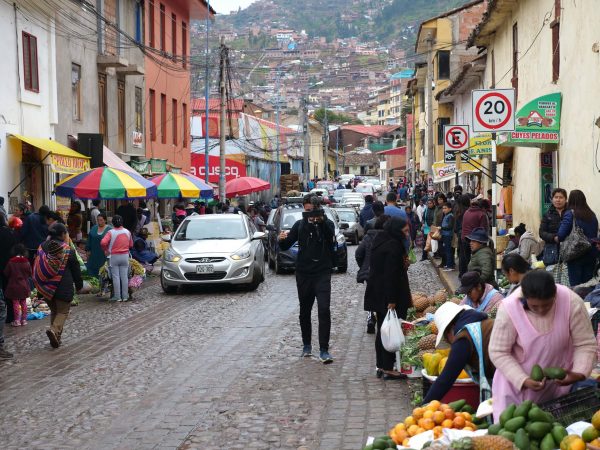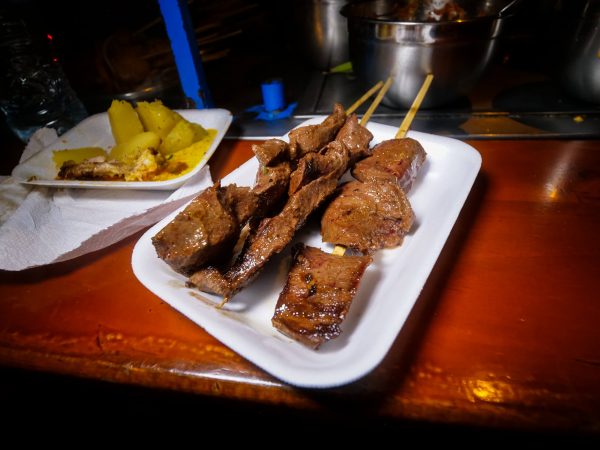
‘Cuy’ is one of Peru’s most tasty delicacies, and its an incredible meal that I can’t wait to share with you.
In this article, I will give you all the details of three wonderful meals of Cuy, some history of this unique South American food, and recommendations for the best places to have guinea pig for yourself, the next time you visit Cusco.
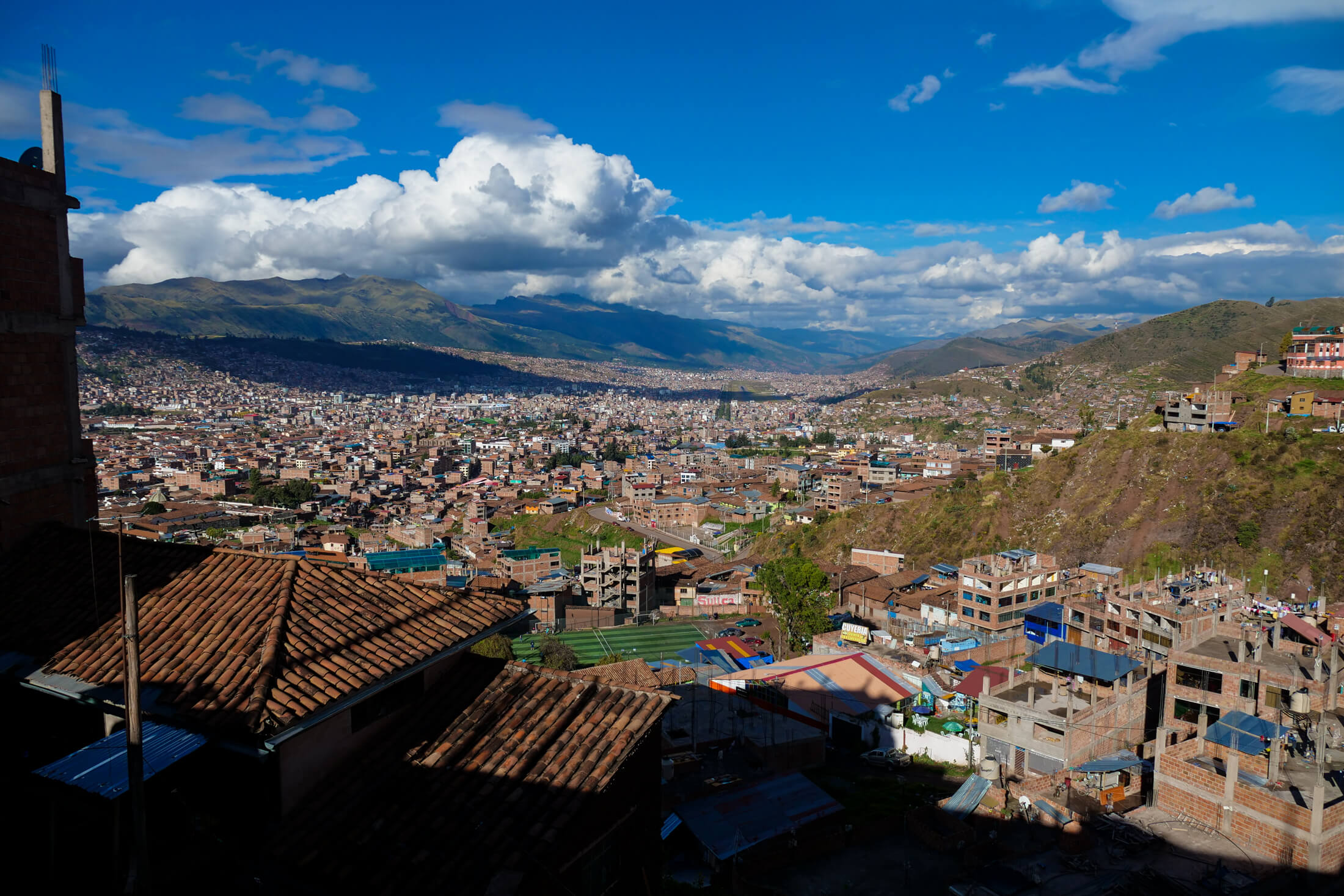
Finding Cuy in Peru
I always enjoy looking at photos of Peru’s natural beauty, and of course reading about ancient Inca culture (Cusco is where people come to visit Macchu Picchu).
Cusco is a city in Peru, and a part of our world I’ve wanted to visit for as long as I can remember.
I always love imagining what it would be like though, to be eating foods of the ancient Incas here with my friends, and in May of 2019, this chance came true – we’re visiting Cusco just to eat!
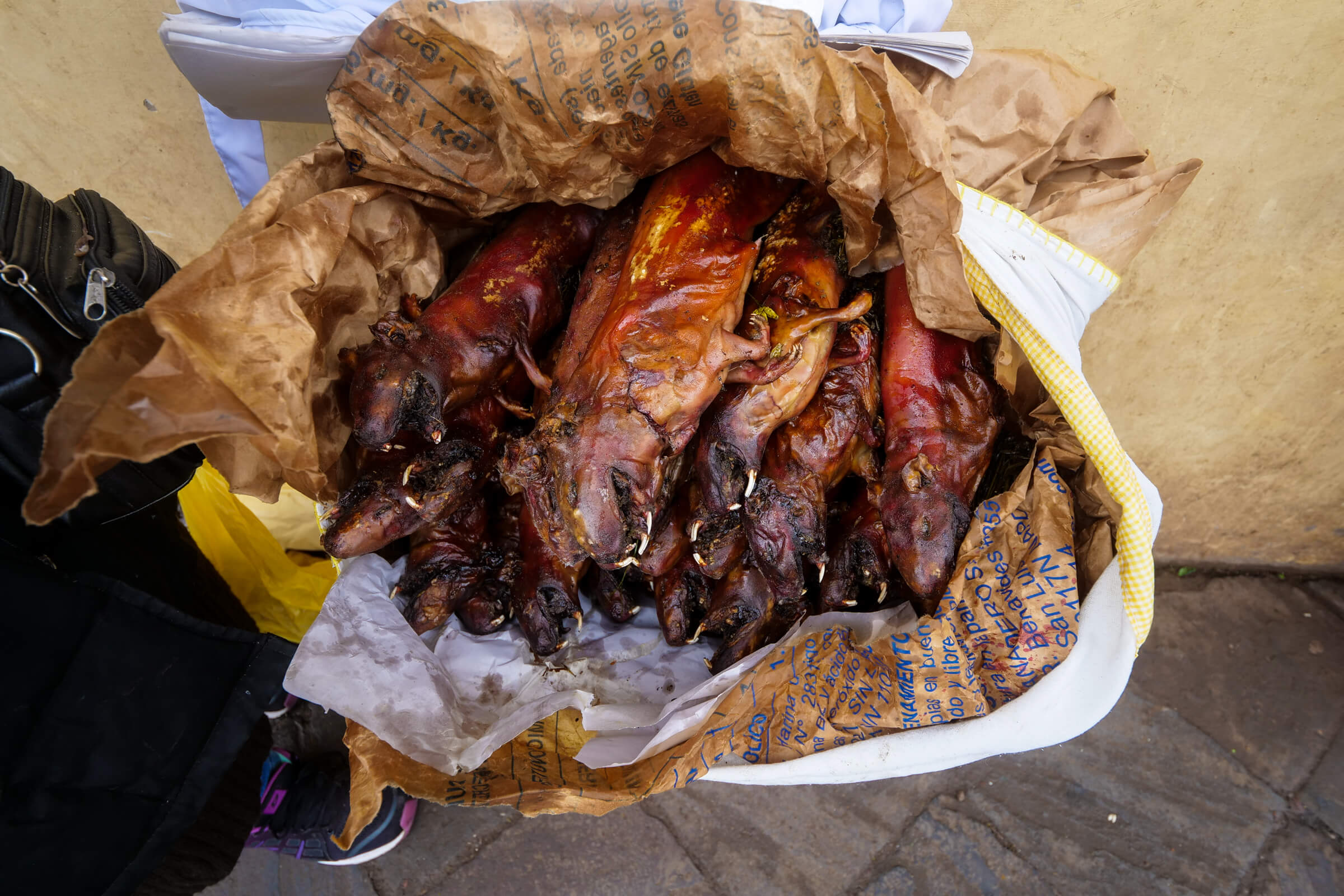
First, Make Your Way to Cusco
In honor of a first visit, you too may want to go a little overboard.
As exciting as the food of Cusco is, it only seems reasonable that when you’re visiting the home of a dish that’s as famous as ‘Cuy,’ its only right to experience everything it has to offer.
We’re Eating Cuy 3 Times Today, in Different Styles around Cusco.
Many people compare cuy to the the rich flavor of duck meat, but I have to say that cuy is totally unique.
And finally, as it really is such a special food in Peruvian tradition, I think this is one meal that deserves to be eaten without bias or presumption.
Now for a day of Cuy in Peru – join us for a day of Cusco’s finest guinea pig.
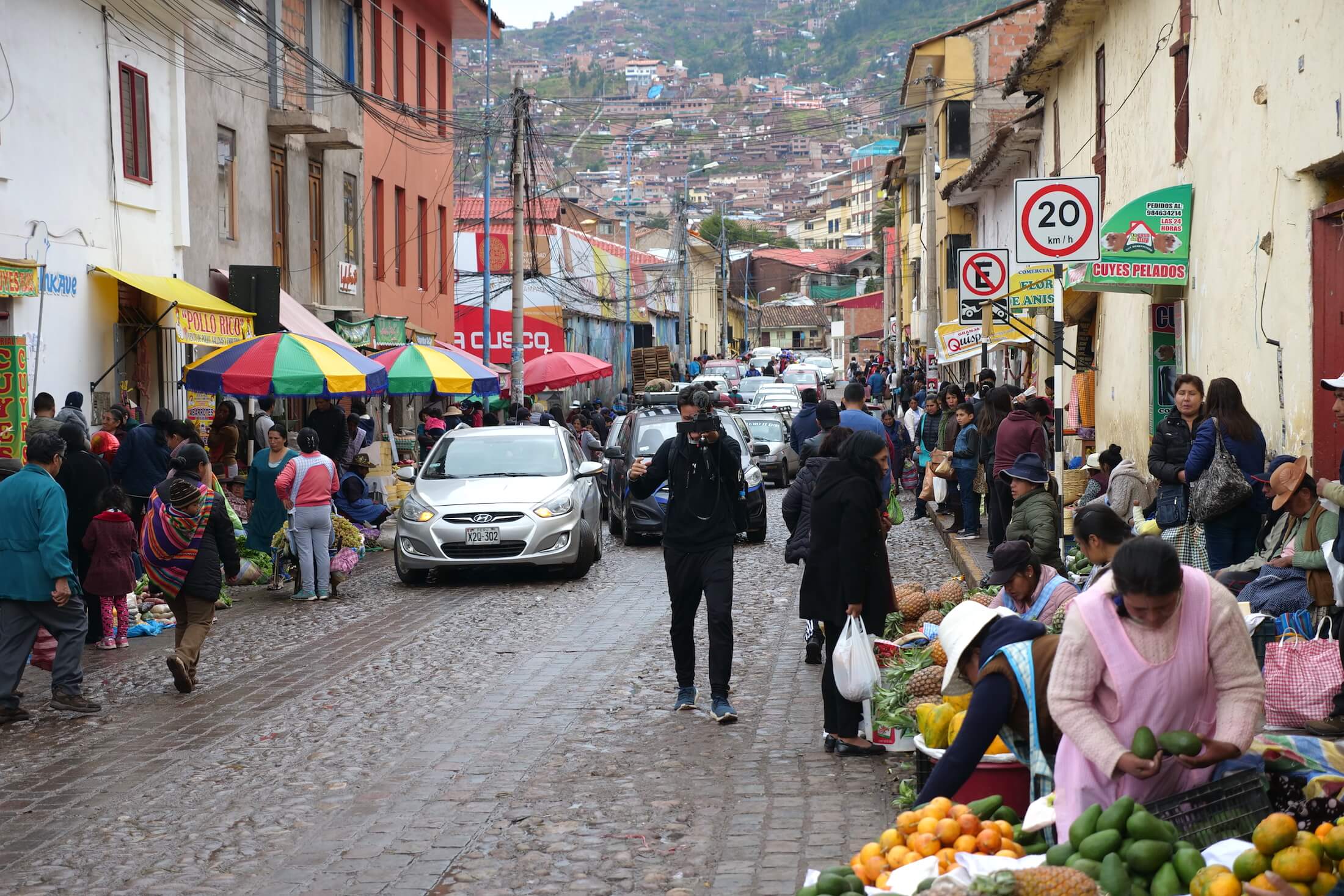
‘Cuy’ is Guinea Pig
A ‘Cuy,’ is a guinea pig, but here in Peru you might just call it the grandfather of all guinea pigs – Cuy is an animal that’s native to the Andes mountains.
The Andes which begin in Colombia, and stretch down through Peru (and all the way to Chile), are a place where historically guinea pigs were raised specifically for eating.
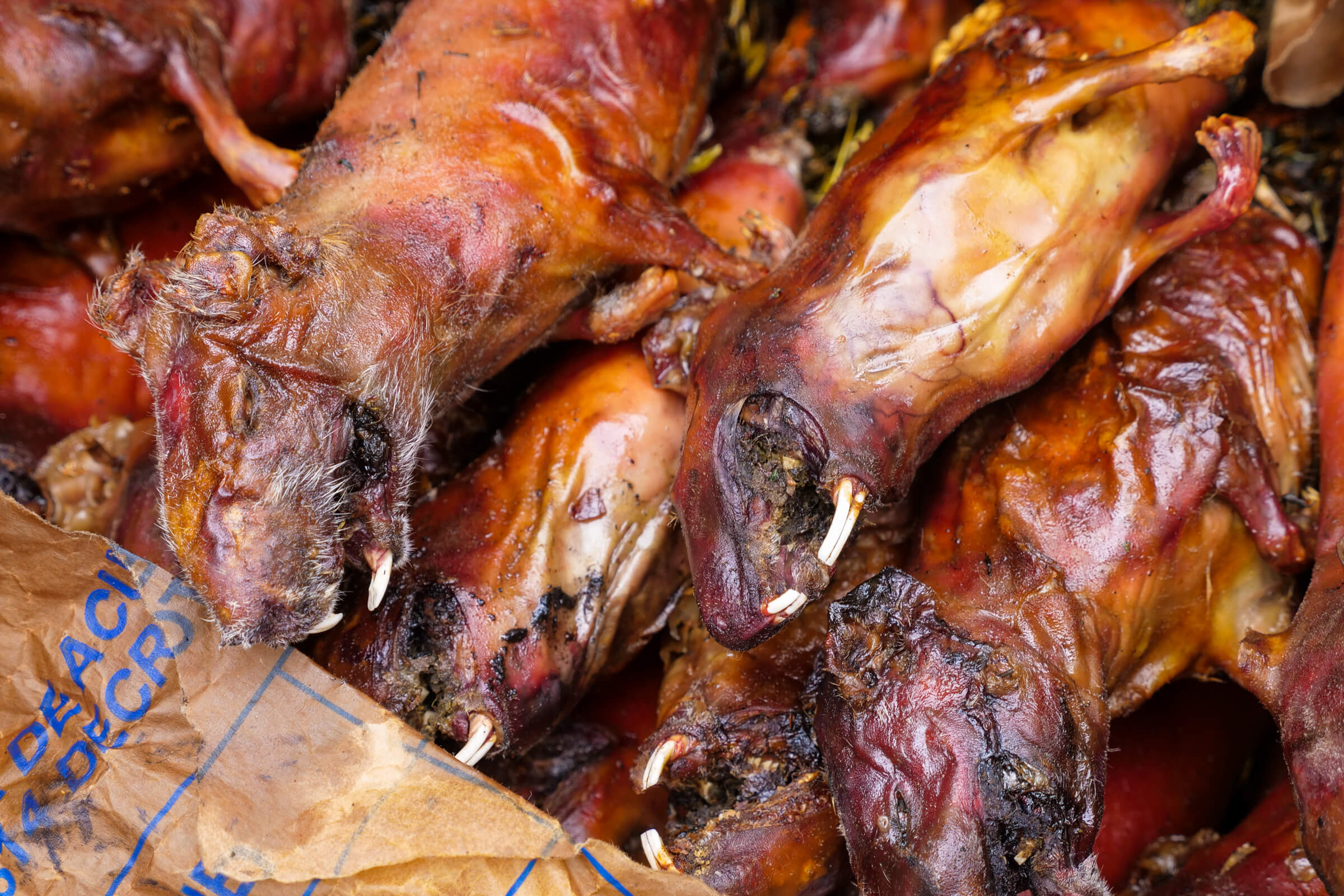
Its Cuy Day in Cusco
Not actually a holiday today,* but this should show our level of excitement to eat Cuy!
The plan is to start with breakfast at a local central market (San Pedro market), and find a meal of Cuy just like one that a local family might be buying to eat at home.
Eating like this is a great way to experience Cuy for the first time (literally on the market benches), as you know there’s nothing extra.
*National Day of Cuy in Peru is actually the second Friday in October.
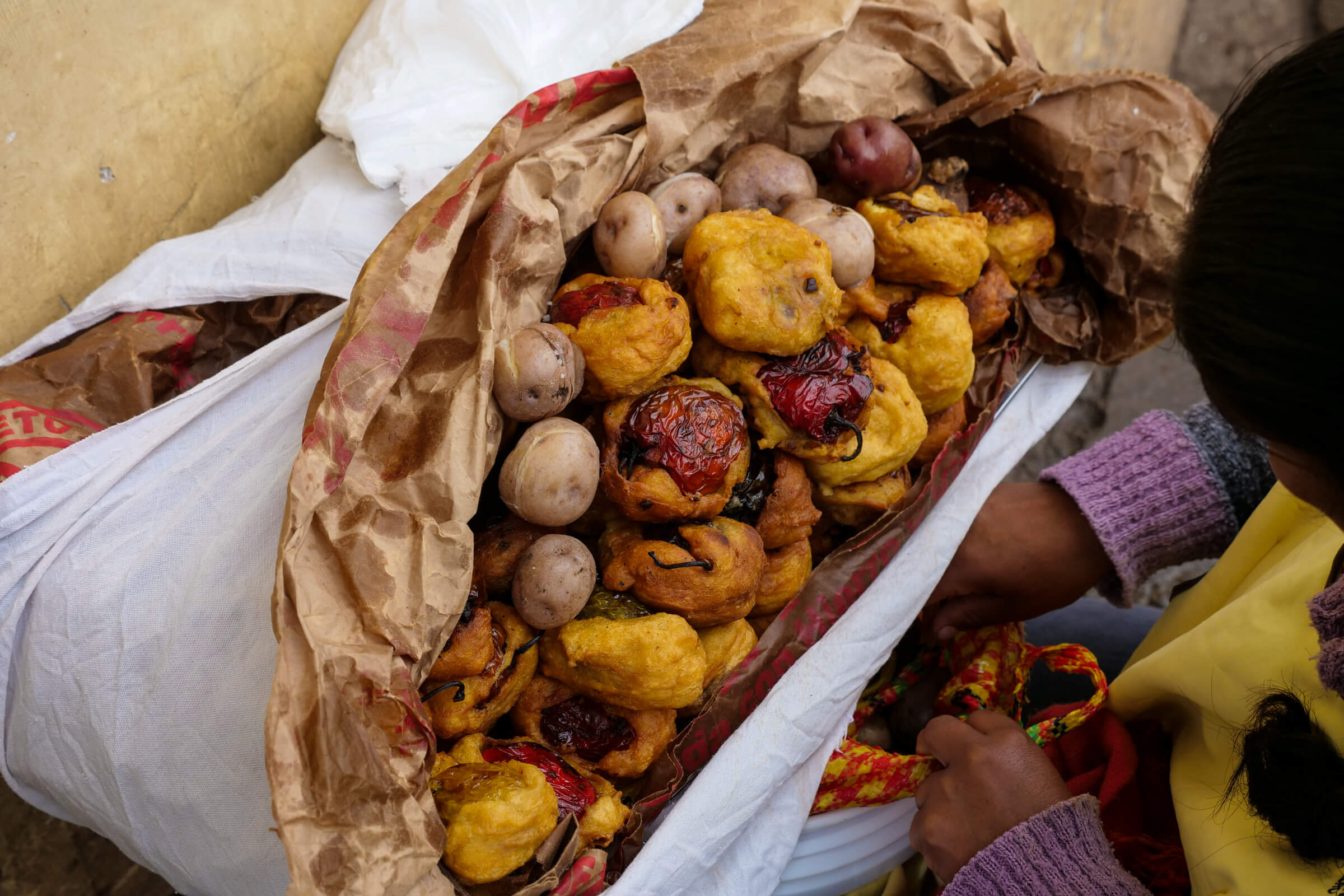
No Plates, No Silverware, Just Cuy
A ‘Cuyeria’ is a restaurant that serves Cuy, and if you want this food from a menu, that’s the sign you need to look for.
Right now though, we’re basically looking for what amounts to ‘Guinea pig as street food’ – we want a pile of Cuy in a basket, and hopefully one of them is ready for us right now – its breakfast time!
No Shortage at San Pedro Market
We didn’t wait long at all, and in under two minutes our friend Edgar happily directs our attention to a sidewalk of standing street vendors.
Seeing the little brown heads of the roast guinea pigs is exciting, and we were exercising restraint to walk over, and not to run, to pick out the first one from under a wrap of brown butcher paper.

Roast Cuy with Huge Amounts of Black Mint
There are many people selling guinea pigs here, and we finally pick out a vendor with some deliciously minty-smelling guinea pigs. We trust our friend Edgar to select for us the best one.
The price we agree upon for one medium-large pig is 50 Nuevo Soles (about US$15), and that should already indicate to you that this isn’t just a fast-food meal in Cusco.
Eat First, Photos Later
This lady selling cuy didn’t want many photos, but when noticing that we were obviously not just in it for the Instagram opportunities, she was very happy to share details, and show off her decent selection.
Her take-away bag includes a few yellow-skin potatoes (adding peppers from the woman selling next to her for another 2 Soles), and we happily take our meal around the nearest corner.
We are quickly searching for a place to sit down, eager to enjoy Round 1 of cuy for today.

First Bites are Incredibly Crisp
This cuy is pre-grilled, stuffed with ‘huacatay’ mint, and encased in an gloriously unspeakable amount of crinkly, reddish-brown crispy skin.
Bubbling up and blistering on the side that’s closest to the fire, the skin is brittle, like thin, oiled pork skin, but does not smell like pork at all.
Infusing into it along with so much smoky flavor too is the almost licorice tasting Peruvian black mint – these first bites of cuy are fantastic.
Layers of Diverse Texture
Inside the cuy, incredibly its not like pork either – I can only think of something super juicy and rich like quail – its obvious that this is not your average fattened farm-meat flavor.
Finally, getting into the parts slightly farther from the belly, the skin is more chewy, and you have to really pull hard to rip off pieces… it’s fun.
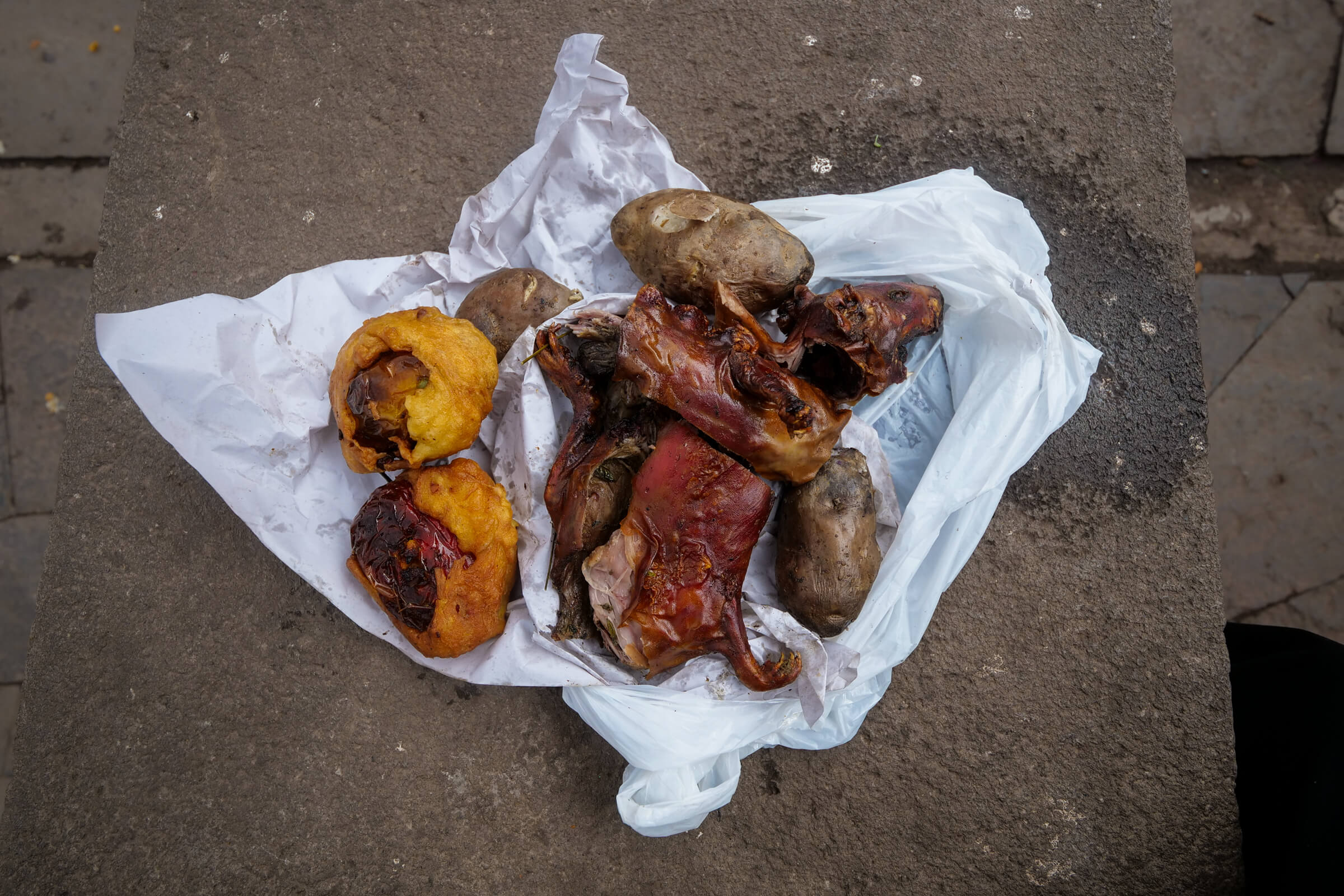
How to Eat Cuy
The best way to eat is with your hands, but you may also get funny looks for eating it any other way.
Go for the skin first, and then you can then dig into the upper layers of meat. Its great to eat just taking your time, moving through incredible textures, until you reach the final and softest layers all the way down inside.
The amount of meat is actually surprising, and you can really be full having one entire cuy all to yourself. This meat is quite rich though, so take time and savor each bite – there are so many different exquisite parts to find.
Our friend says that the the neck, the hands, and the innards like heart or kidney, are more tasty than the ‘normal’ parts of cooked cuy, and at home, these are the parts people fight for!
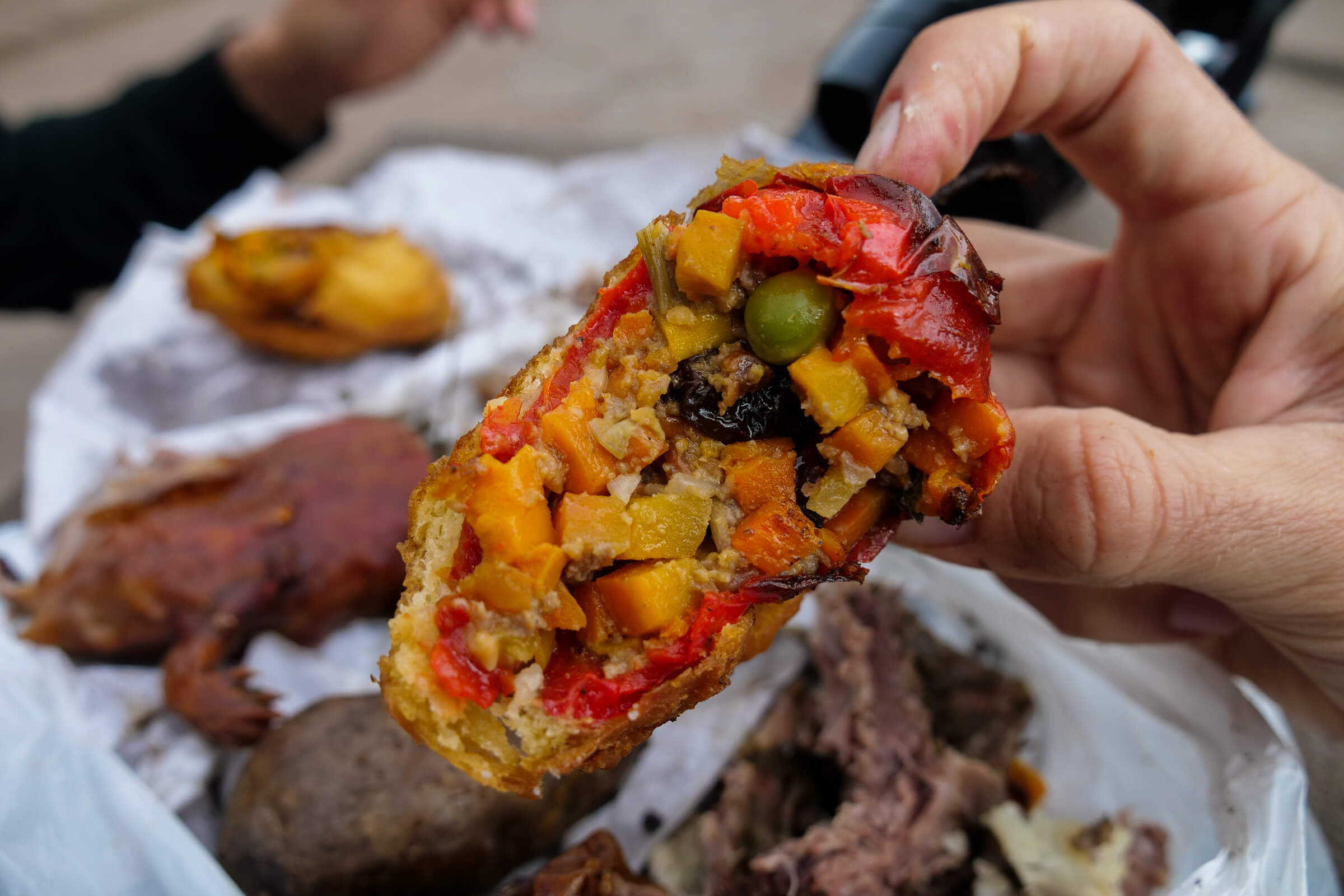
Success at San Pedro Market – Round One Complete
Around the back of the San Pedro market, there’s a wide open space where we could find a seat.
We may have been eating on a bench, or actually just a cement decoration in the courtyard, and we didn’t even have plates to eat from… but it didn’t matter in the least.
Our first cuy meal is wonderful, and we walk back to the car in a bit of a daze.
Breakfast of Cuy at the San Pedro Market is a success!
Name: San Pedro Market
Location: Google Maps (link here)
Hours: Open Daily from 6am – 7pm
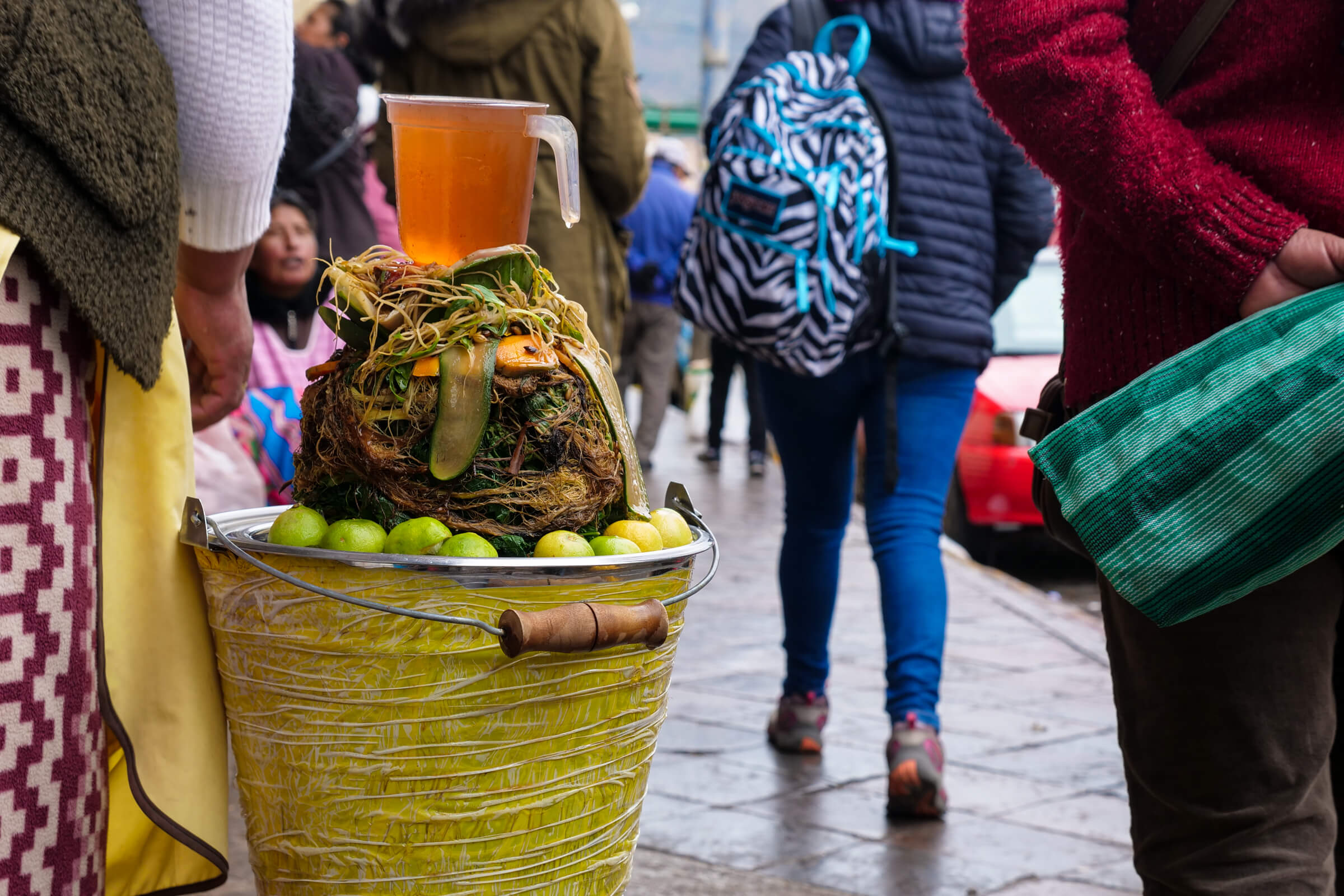
San Pedro Market
This is a great market for a walking tour, and we actually will come back here the next day for more exploring – for that massive street food tour of Cusco, check out a video clip here.
This morning however, just wanting something warm after our meal of cuy, just a cup of ‘mate’ along the way is perfect.
‘Mate’ Tea with Fruit, Veggies, and Herbs
A lady standing near the market’s front entrance makes this tea using an absolutely massive amount of herbs, and even vegetables as well. She adds some sugar and squeezes in lime juice before handing it to you in a glass.
(Most people I notice have her pour it into their own container, 1 Nuevo Sole for a large cup)
Its Even Environmentally Friendly
The flavor is quite complex, and the texture is just the tiniest bit gummy – I could drink this interesting sweet tea-herb-fruit-juice all day.
She actually uses glasses instead of plastic cups, which is excellent, but it means that you’ll need to just drink the whole thing right there (and she also gives you one free refill!)
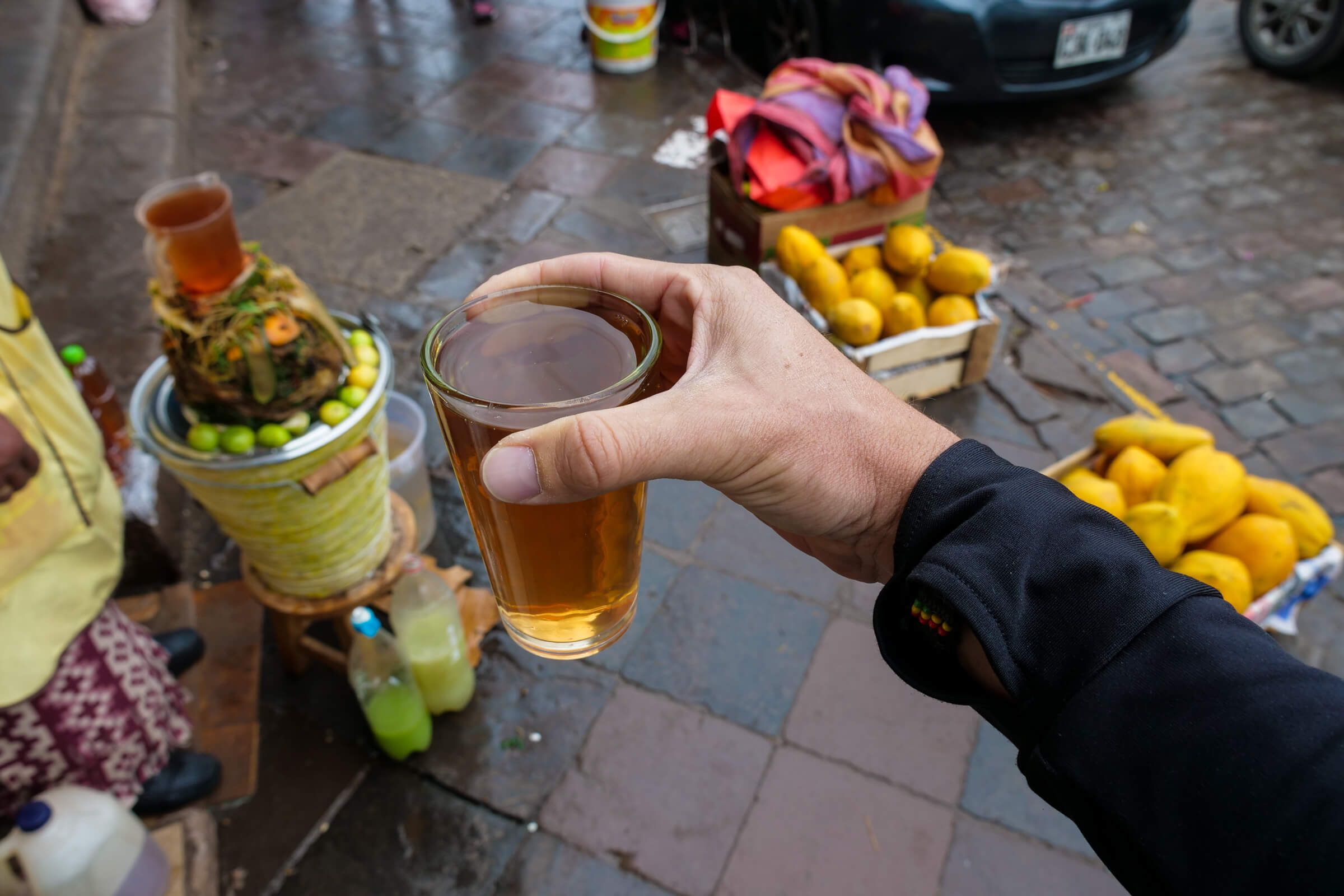
Quick Facts for Your After Breakfast Reading
The best estimate I see online says that Peru eats 60-65 million guinea pigs each year, just slightly less than the estimate for guinea pigs people keep in the USA for pets (link).
Fun numbers to compare, but the fact is that guinea pigs are a better farming choice in many ways over larger animals. Most importantly, they take up much less land area (creation of grazing lands for livestock being the leading cause of rainforest deforestation (link)). Guinea pigs even eat less as well.
Proportionate to their body weight, they eat half what larger animals do, and when its finally time for us to eat the guinea pig, its even a healthier meat choice (very low in cholesterol) (link).
In short, cuy are a much more sustainable meat to use for human consumption, as well as being, honestly, quite delicious (link).
Enough science, let’s get to our second breakfast!

Guinea Pigs for Health!
The friend we are traveling with today recommends the meat of cuy for any sickness that is weakening the body. Peruvian people know (and also believe) the meat of guinea pig to be more healthy than the average farm poultry or red meat.
Our friend is not a doctor, but these are clearly local beliefs that pass down from tradition – locals here love cuy, they respect it for many ways, and eating it is a huge part of life in Cusco, Peru.
We are now almost to our second destination for the day, having a second breakfast in the town of Tipón.

Tipón, Peru
It is unmistakable to see why this town is famous, as even the statue welcoming you to the town’s central intersection is a Peruvian woman in traditional dress, serving up a larger-than-life size plate of cuy.
There are plenty of restaurants to choose from in Tipón, but our plan is to find one that cooks using a clay oven, making “Cuy al Horno” the traditional way.

Where to Have Cuy in Tipón
The next place on the cuy agenda today is Cuyeria Mónica. This town of Tipón is actually the most famous place among locals when its time to eat cuy, our friend Edgar was surprised we even wanted to go anywhere but Tipón.
Baking using a clay oven is the most common way to cook cuy, but we also wanted to come here to experience the entire atmostphere ourselves.
After watching her pull our guinea pigs from the oven, this is looking like a wonderful place to be.

Cooking like a Pizza Oven
The way the oven heats is like a pizza oven, with the flat floor inside, a stack of burning wood on one side, and the heat emanating out a small, accessible front door.
Stand in front for more than a few seconds, and you will be salivating uncontrollably.

Cuy al Horno
Adobe mud bricks make the oven, as well as some heat resisting porcelain tiles that make it easier to slide food in and out.
Covering the outside of the oven with smooth clay helps keeps the heat in of course, but also the shape of the oven is special – it cooks the meat differently than it would just using the same wood under a grill.
Heat is coming more evenly from all sides, and the chef can just rotate a dish or (with the spaghetti) give it a few stirs, to make sure that no single side gets too much heat before its done.

Quick Mid-Morning Snack
Arriving right around the chef’s and owner’s own lunchtime, there are a few minutes to catch our breathe, and snack on some massive choclo corn kernels.
Peru is home to corn by the way, and although you can enjoy an incredible amount of corn in Lima, (on a street food tour), the size and variety of corn in Cusco will absolutely blow your mind.
This plate may have the largest single kernels of corn I think I’ve ever seen, and there’s so much moisture inside each one that they actually gush with milky flavor as soon as you bite into them.
By the way, I want to include vegans and vegetarians in this post as well – its not only the corn, also the potatoes here are amazing (probably the world’s best french fries), there are plenty of amazing meals in Peru that don’t have any meat at all.

Second Breakfast Begins
The chefs are ready, and the fire is hot. Smoke pours out of a chimney on top, directing it out to lure in other hungry customers.
(and it works too, a large delivery truck immediately pulls up to grab several plates of cuy to-go)
Everything in One Clay Oven
She cooks all the food she serves here right, all inside the same clay oven in front.
We order a full meal, which at Cuyeria Mónica means a lot of other local additions to go along with our cuy.
There’s Even Pasta
There’s pasta today, which she parboils in hot water before she transfers it to a tray. She mixes in eggs and butter (mantequillia), before putting sliding it into the clay oven to finish cooking.
She stirs it occasionally so that it cooks evenly, not overly hard on top, and together with the cuy it makes this second breakfast quite a feast for sure.
The pasta is still quite chewy, as it just cooks in the dry heat for a few minutes, and is yet one more example of a ‘simple’ food that I never thought I would enjoy so much here in Peru!

Golden Potatoes
She also serves potatoes (papa), and they’re full of smoky flavor as well.
You will absolutely love the texture of the potatoes here, and I’m not kidding – sometimes you can even just scoop the skins out with a spoon the inside flesh is so creamy.
Finally, the Stuffed Peppers
Then finally there’s the pepper… not a meal of its own, but it is so delicious that you can’t possibly refuse.
Honestly though, no meal of cuy will be complete if it doesn’t come with at least one beautiful red or green local Rocoto (flaming hot)* pepper.
Rocoto rellenos are an amazing food on their own, and here at Cuyeria Mónica they come with an incredible amount of ingredients inside.
*I’m even still day-dreaming of Cusco’s Rocoto chili fire right now.

Rocoto Rellenos
Cooking in that clay oven, there’s enough heat to grill the pepper’s outer edges, while inside it will still be soft and creamy. If there is enough cheese inside, you will see a wonderful volcano effect with glorious amounts of white cheese just bursting out the sides of your pepper.
Each bite of the rocoto as a whole has a flavor profile that just leaves you in happy amazement, and adding that with a nip from a raw rocoto as well, makes sure to light a fire in the mouth as well!*
The Ingredients
In the pepper comes sweet carrots, peas, cloves, cinnamon, mint, and as the top is sliced off, a chunk of cheese is the final ingredient, and the pepper top is put back on.
This has the potential to be one of the spiciest foods in all Peru, but actually the way they prepare the chili can vary greatly.
How to Make Rocoto Rellenos
Most of the time, they will remove all the seeds from these medium-length, fat Rocoto chili peppers. After this, they even soak the pepper flesh for 1-2 more days to lessen the heat.
After this, only then does the chef stuff the pepper, and then cook it – either roasting on a small grill, or traditionally, in an earthen oven, like at Cuyeria Monica – and even then it can still be slightly spicy.
These peppers are no joke, but they’re easily some of the most delicious and flavorful peppers on earth.
*For real chili lovers, make sure to try a fresh rocoto. You might have to ask for it specially, because most people don’t eat them raw, but I would say this is easily one of the most deliciously hot peppers that I’ve ever eaten. Experiencing them several times in Cusco, always tearful, red in the face, and widely-grinning with pure joy).

Traditional Feast of Cuy
Moving between bites of the soft potato, thick pasta, and gorgeous balance of ingredients in the pepper, I still have to give it up to the flavor of Cuyeria Mónica’s roast cuy.
The hind legs and back are especially sensational, I am just in awe of the depth of flavor that cuy meat can contain.

Black Mint Stuffing
You can see the amount of Peruvian black that chefs will stuff into the cuy’s body cavity before it cooks.
It’s hard to describe how this infuses literally every single bite with its flavor. With so much filling inside, the flavor even penetrates and works its way while cooking, all the way to the outer-most layers of skin.
Not just minty-ness either, I can’t help but think of licorice – actually it reminds me of Thai sweet basil – the flavor is wonderfully rich, like no other single herb I know.

Last but not least, notice how the intestines are already gone. This is what creates the open space for all that mint in the first place.
Also useful themselves, and good to eat, but the traditional style is to remove the intestines, clean them, and use them in a separate dish (an example of which you will see at the next restaurant back in Cusco).
Restaurant Info Below
The total for everything today is 110 Nuevo Soles, or PEN (equals about US$32), and that price includes many drinks and another plate for take away.
Name: Cuyeria Mónica
Location: Google Maps (link here, GPS co-ordinates only)
Hours: No hours online, we came for lunch
Price: Cuy are 35 PEN each today (US$10).
Get exclusive updates
Enter your email and I’ll send you the best travel food content.

Final Round (of Guinea Pig Info)
During the drive back to Cusco, Edgar tells us a few more stories he remembers of local information about cuy. Learning from him, and doing some fact-checking online, there are still a few more interesting things I want to share with you.
Caring for Cuy at Home
In the past, Cuy would live their lives both inside and outside of a family’s home, and an average Cusco farming family would take care of 50-60 cuy.
In the warm weather of summer, the cuy would fatten, reproduce, and spend more time outside, while during the cold months they would live mostly in the kitchen, keeping warm, but also doing a household duty.
Peruvian cuisine includes a lot of delicious potatoes, the shavings of which can add up quickly. The cuy would keep food waste to a minimum, eating the scraps and other leftovers, and then the family could eat several cuy each winter month, not having to pay as much for hay or grass to feed larger animals.
*There is an increasing amount of real research going on today, here’s a short article that does a great job of explaining why we should all have more interest not just in cuy, but in more sustainable meats and knowledge about the meat industry in general (NPR Article).
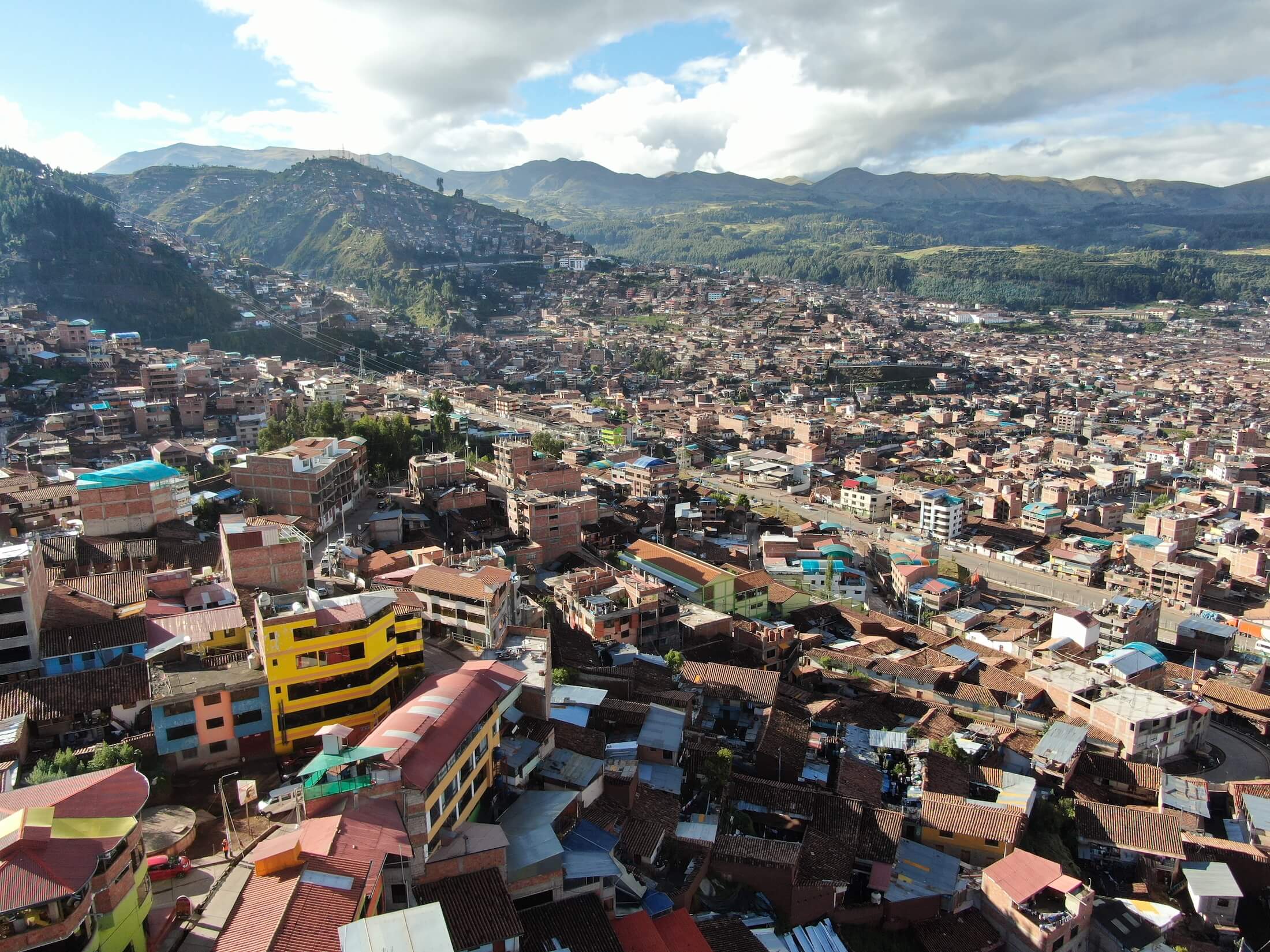
Final Round of Cuy
Honestly speaking, if you are really pressing it for time and can only fit in two meals of Cuy today, then I guess that’s all for now.
However, letting our own experience speak for itself, allow me to give you some motivation here – a final round cuy is pretty much mandatory, as there is still another (amazing) style of cooking cuy here to try!
Three is the Correct Number Today
If you do have a clear schedule today, and you’re ready to go all out, then three is the correct number of guinea pigs you should be eating.
Your final round awaits at ‘Cuyeria Sol Moqueguano.’
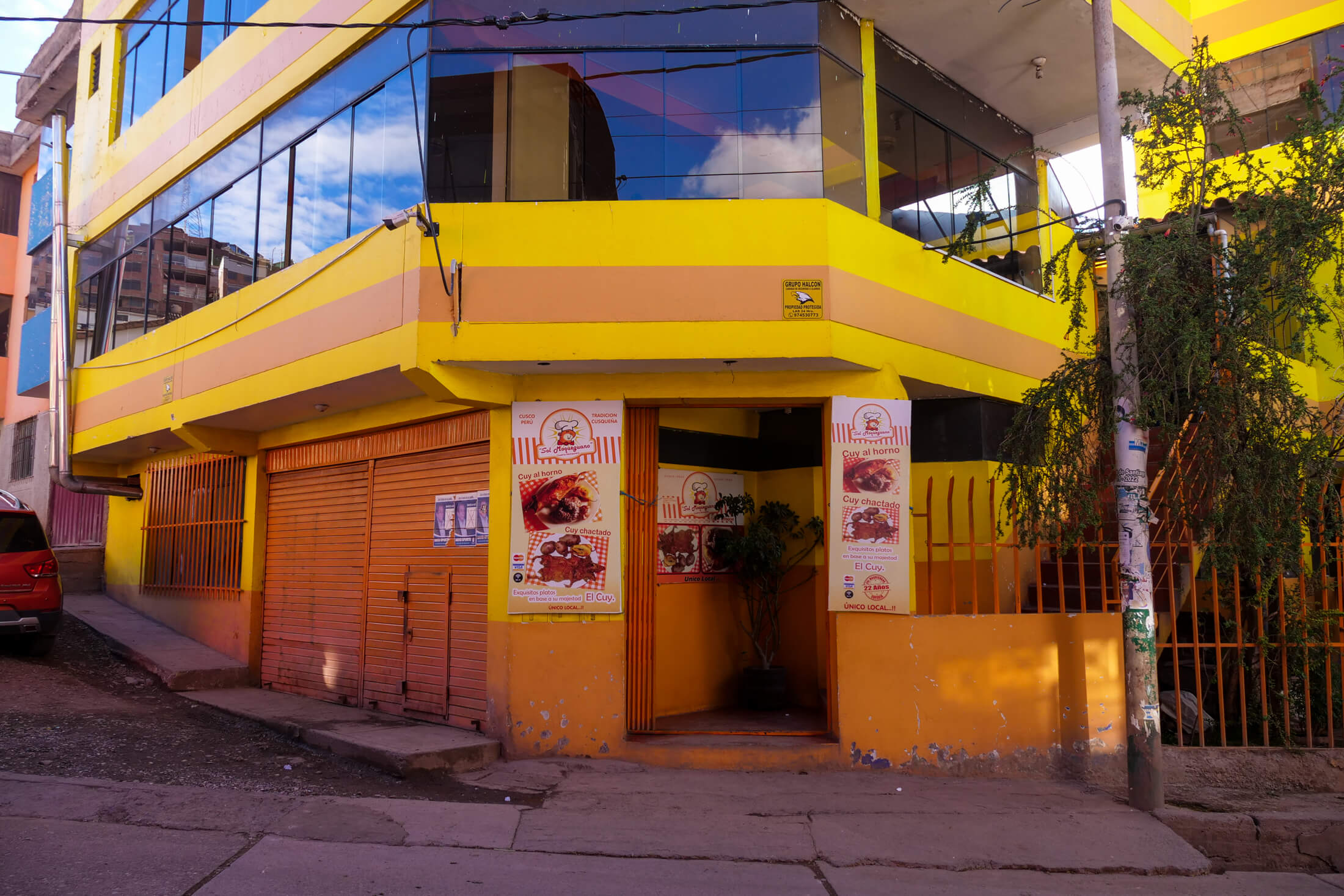
Cuyeria Sol Moqueguano
Arriving back to Cusco at around 1pm, there is one final question we have for our friend Edgar.
“If you were to go out for a party with your entire family right now, where’s the place you would take them?”
He didn’t even have to think for a second before exclaiming, “Oh, Sol Moqueguano, for sure!”
Turning the car towards the restaurant, a good day gets even better…
Arriving at the Restaurant
Pulling up to Cuyeria Sol Moqueguano, there is already a line reaching down to the front steps.
Edgar assures us that everything is in order, and that this restaurant “serves maybe 1,000 guinea pigs a day, maybe even more.”
There is real excitement in the air, and right from the start you know that cuy here is simply being done on another level of expertise.

How to Order
You have to wait in line to order and pay first, and then look for an open table.
The roast Cuy (cuy al horno), is 42 Nuevo Soles (PEN), and the deep-fried Cuy (cuy chactado), 37 PEN.
Unless you’re coming alone, you are probably going to need one of each. The way they understand guinea pig cooking-technique here, both styles are delicious beyond belief.
The Atmosphere at Sol Moqueguano
The restaurant is so full that the first seats we can find are up on the third floor.
There are men playing lively acoustic music in the room, adding even more energy (if that’s even possible), and our drink orders arrive as we’re sitting down.
In an instant you may forget all other meals today, or maybe in the world…
I think I am exactly as happy to be sitting down for this cuy as for any other plate we had today.
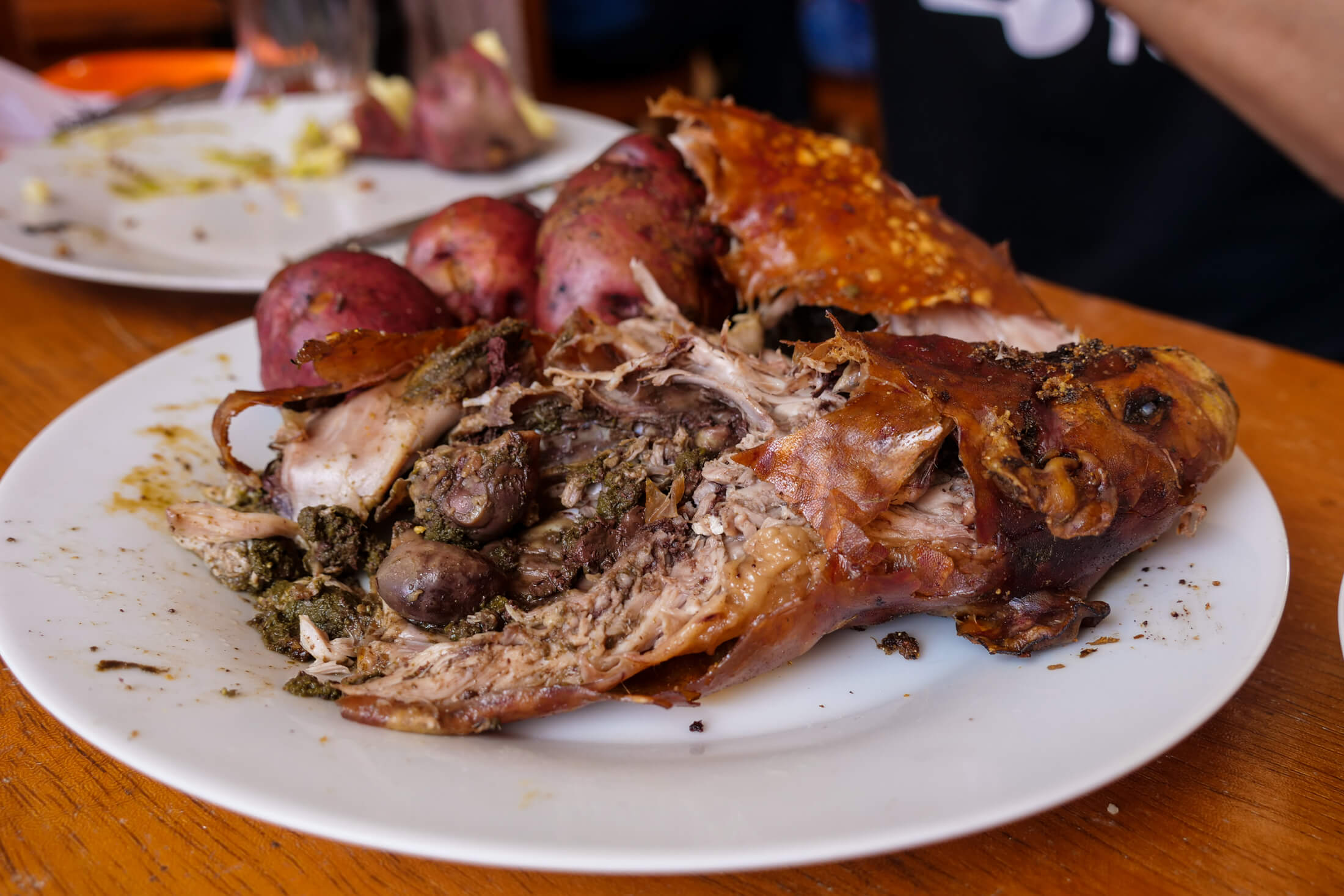
Our Order Today
You are going to need to order any drinks downstairs as well, before you sit down, and here is our order for your reference.
Limonada, 10 Soles for a huge carafe, and water is 2 Soles per bottle (this is juice from the ‘subtle lime,’ the small and amazingly sour Peruvian limón).
Local black beer* Cusqueña Negra (7 Soles, or the Golden lager is 5 Soles).
One order of Cuy Chactado (entire, but they also do half-cuy orders), and another Cuy al Horno.
*Get the black beer, it has incredible roast-chocolatey flavor (one of the better non-craft beers I have ever had actually), but remember – if you’ve just come from Lima (at 0 meters), up to Cusco (3,400 meters or more), any alcohol is going to have even more effect than it otherwise would. Actually, get the limón Lemonade too, because its just amazing pretty much anywhere in Peru.
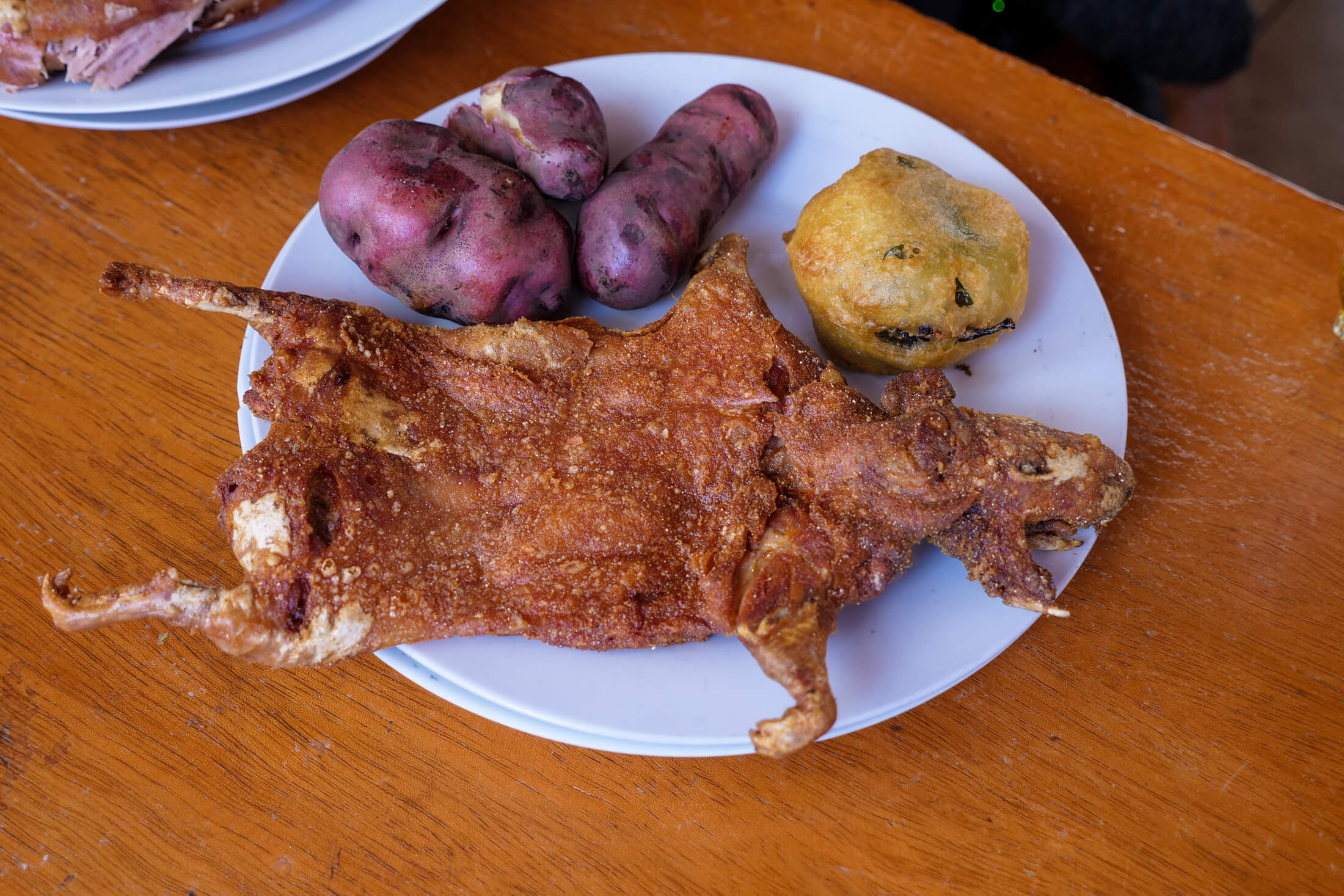
Cuy Chactado
Guinea pig is already quite rich, so whoever first thought to deep-fry an entire cuy… I simple have to applaud and congratulate their genius.
Eating Cuy Like A Local
The order you’ll see on most tables here is a half-order of cuy, which they serve with potatoes, aji green chili sauce, and a rocoto rellenos chili pepper.
Many people though, are going for the full plate of cuy chactado, and this is what I also have to recommend to you today.
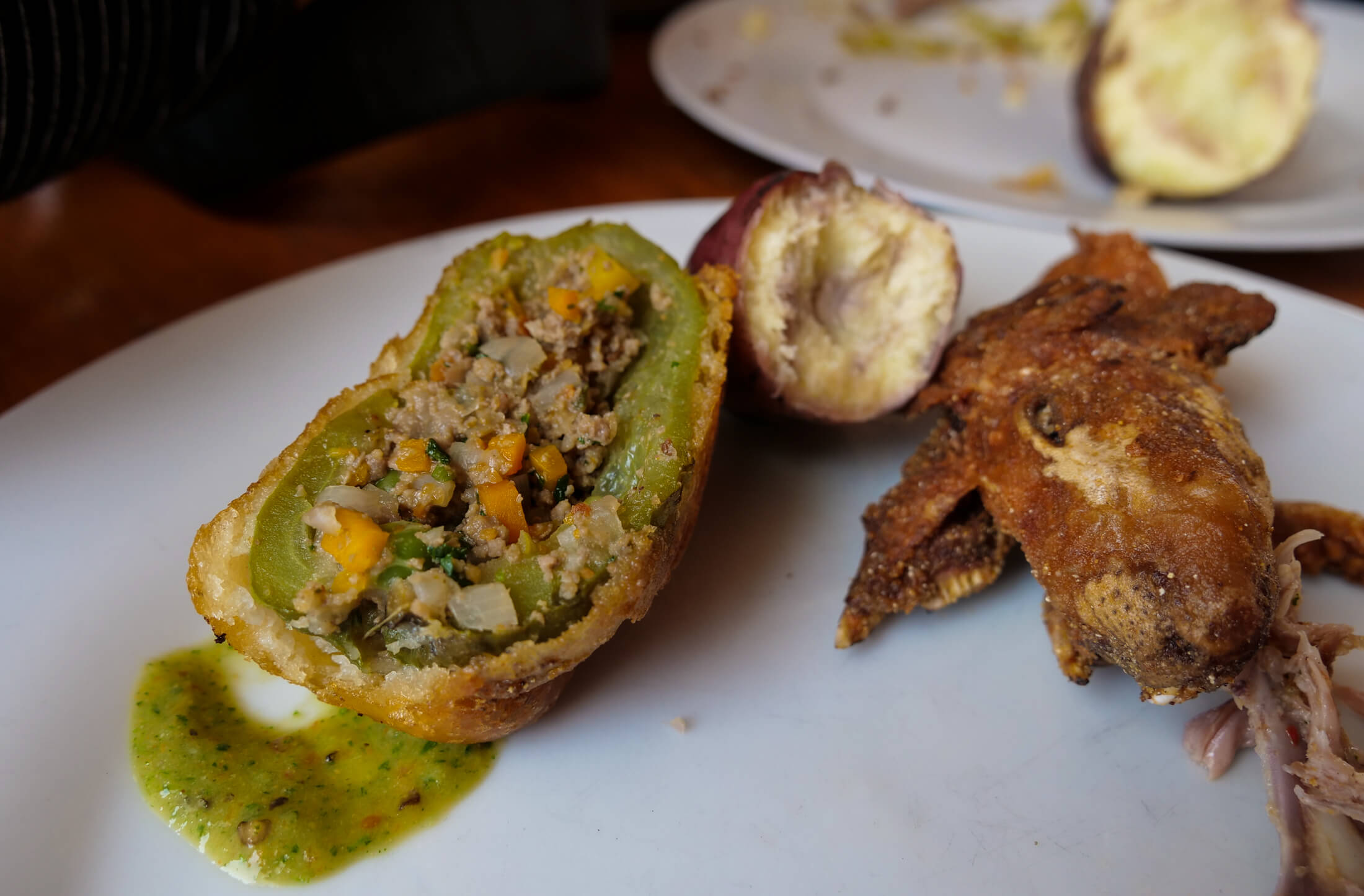
Bonus Aji Dip
Suddenly it is obvious there how there is something missing from the other meals of cuy today – the aji chili dipping sauce!
It really comes with the potatoes, but it tastes great on absolutely everything. Maybe we just forgot to ask earlier, but this restaurant just serves everything to you from the beginning.
Don’t miss the dipping sauce, and if you can find yet another fresh rocoto chili to add to it, you’re in a great place indeed.
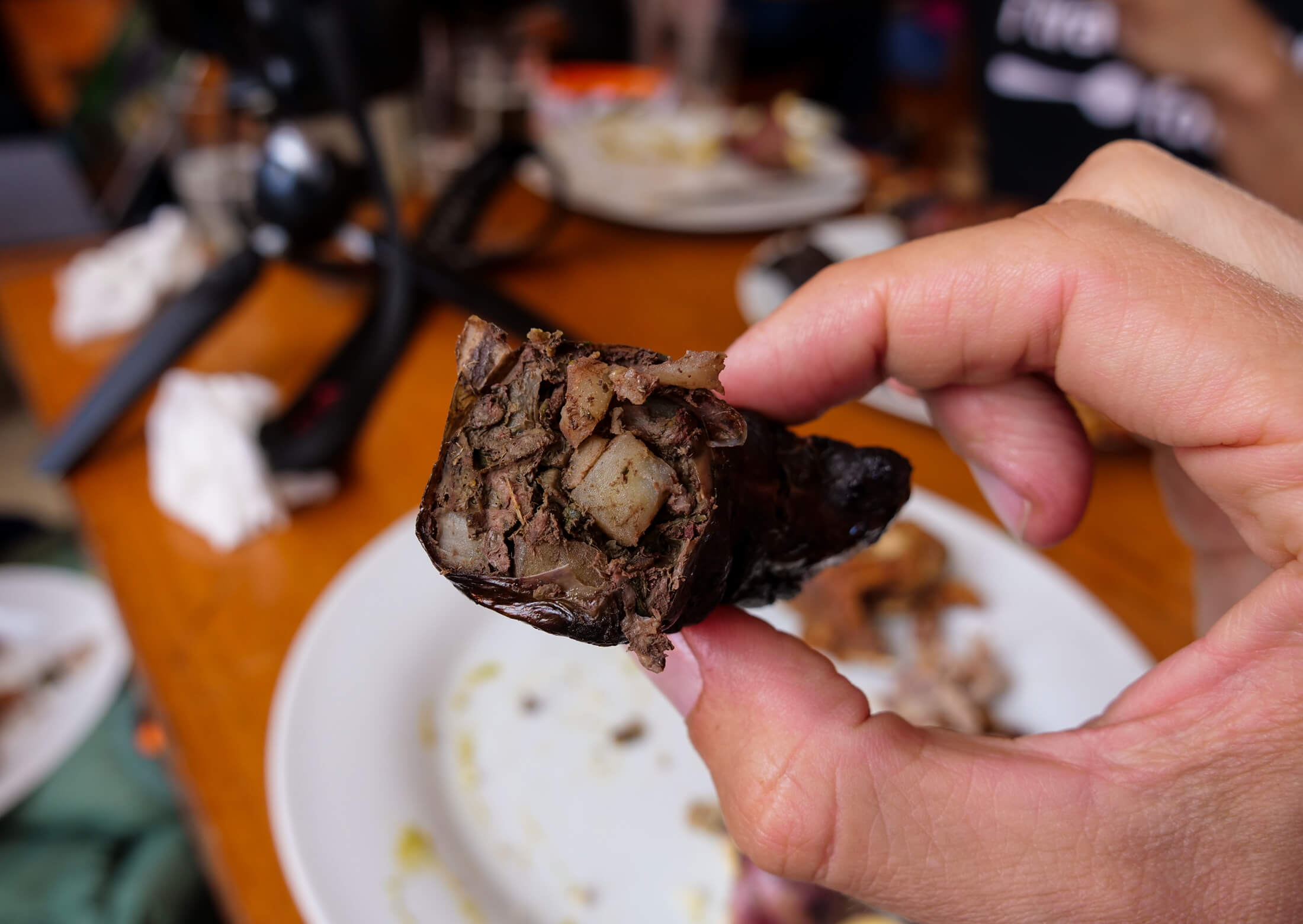
Special Sausage for Dessert
It has come down to the last bite of the day – the Cuy Sausage!
No matter how full you are, this item is still so delicious, I have to take a few more lines to describe some truly incredible texture genius.
Cuy Sausage
Without looking, its almost as if there are chunks of french fries inside, amidst bits of oily cheese – and sour slightly sour at that.
A key part to any great sausage is texture balance, and this cuy sausage is outstanding.
Its obvious that there is also a large amount of blood in this recipe, and I wonder if the sourness is from slightly-fermenting ‘moraya’ potatoes as well.
The sausage is amazing, and I am glad we got to try it to end this amazing day in Cusco.
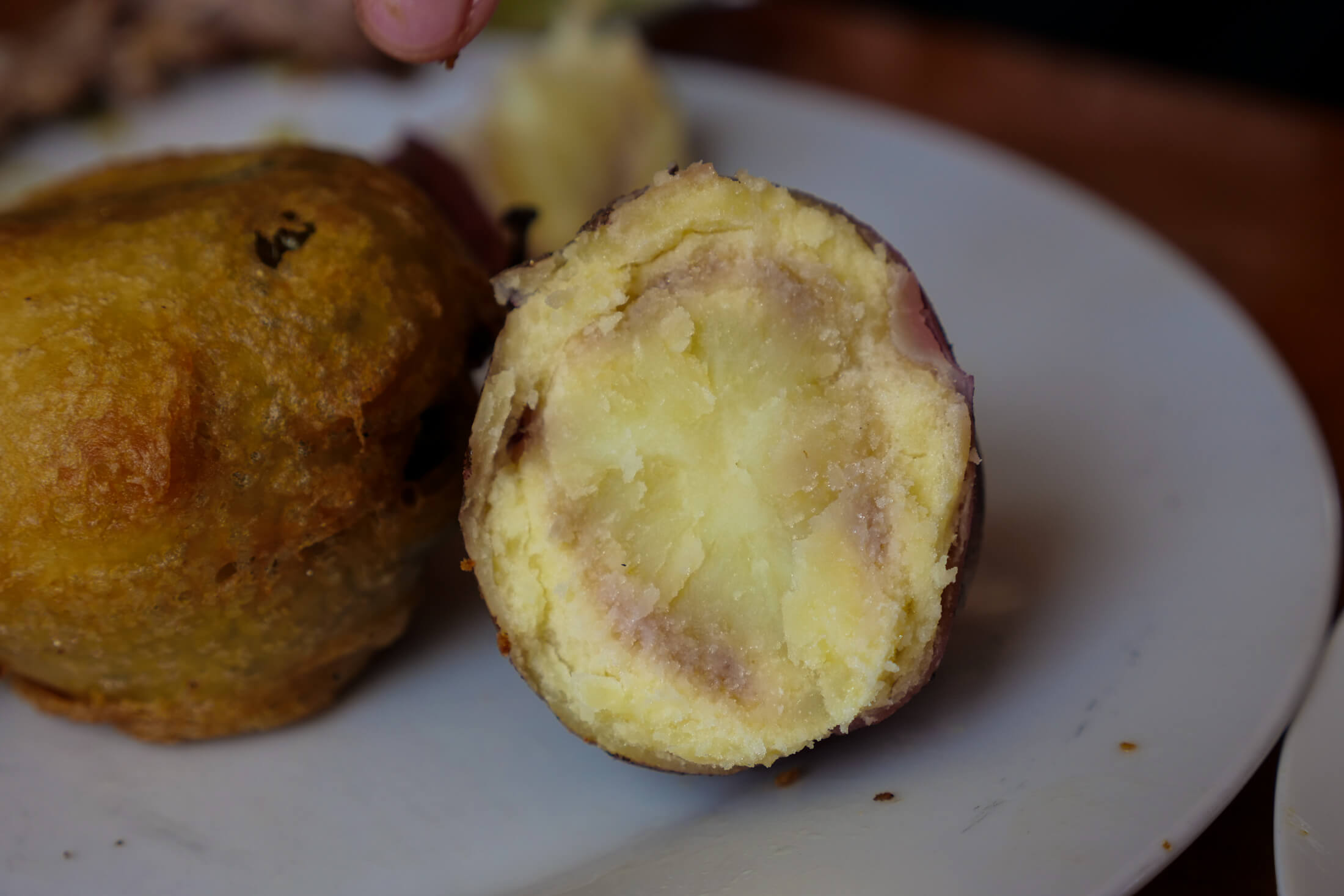
Different Styles, All Delicious
No matter if you share one, two, or five guinea pigs in a single day (and our consensus is down below), the differences between restaurants and styles are still noticeably clear.
There are a few recipes for this food around Cusco, but there are also a huge variety of different atmospheres and styles in which you can enjoy the tradition of cooking cuy as well.
Besides the great flavor, and uniqueness of a new and amazing food, it was also just a great experience overall today – thank you Peru, thank you to our wonderful friend Edgar, and thank you to each of the amazing chefs, sharing with us their own takes on this amazing dish of ‘Cuy.’

Great Days in Cusco
On the whole, I can’t say that any of these meals was better than any other, as atmosphere really does affect the outcome of a superb meal. All 3 Cuy experiences today will be so different, there’s no point to compare…
However – in terms of pure flavor, its no comparison – Cuyeria Sol Moqueguano is THE Place.
If you’re looking for only one Cuy guinea pig today, this is your spot. Make it easy on yourself, and come early – don’t wait for a timely late lunch today, this place is likely to be packed before noon.
It is immediately obvious arriving at Sol Moqueguano that this is the restaurant where local people love eating Cuy with the entire family.
Name: Cuyeria Sol Moqueguano
Location: Google Maps (link here)
Hours: Open Daily from 1130am – 6pm
Price: Total price for our meal (4 people) came to 99 PEN (US$30)
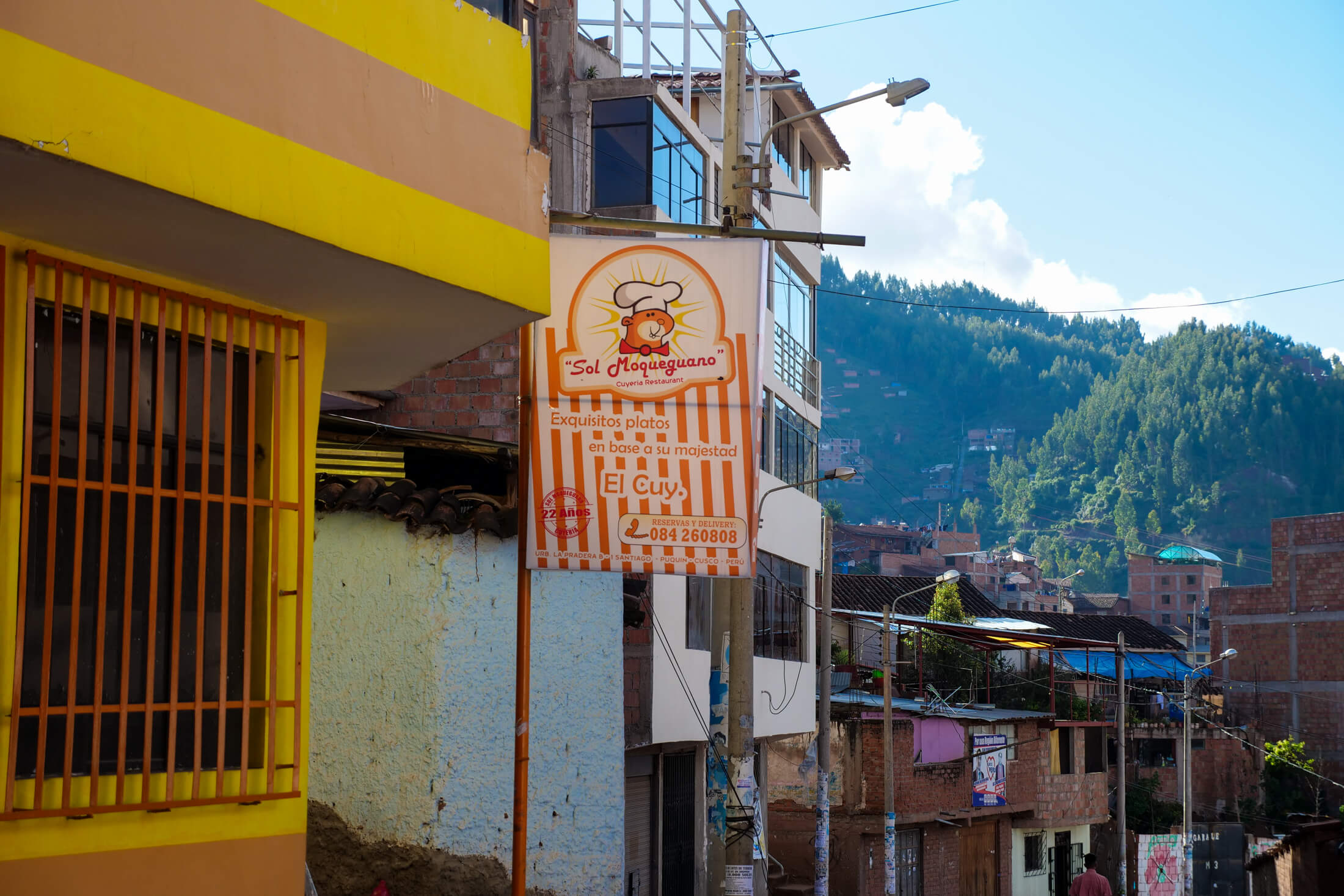
The Consensus Is…
Tipón is obviously the cultural center when it comes to the tradition of cooking Guinea Pig – If you’re looking to experience the full history of this amazing food of ancient Peru, then Tipón is the place.
Just a 40-minute drive, a beautiful drive too, this is authentic and traditional country side cooking, and a great experience (its also just amazing to arrive in Tipón and have your welcome be a larger-than-life statue of a chef serving roast Cuy).
In the downtown Cusco streets though, the large city inevitably draws in a few great examples of food from all the surrounding countryside areas, just like any metro area in the world would.
There are many restaurants serving Cuy in the city streets as well,
You Need to Have it Once
While I personally will advise you that 3 in one day is probably the correct number, our final consensus is…
You absolutely cannot visit Cusco without having at least one entire Cuy guinea pig, all to yourself.
Thanks for reading, see you for the next article!
Get exclusive updates
Enter your email and I'll send you the best travel food content.


